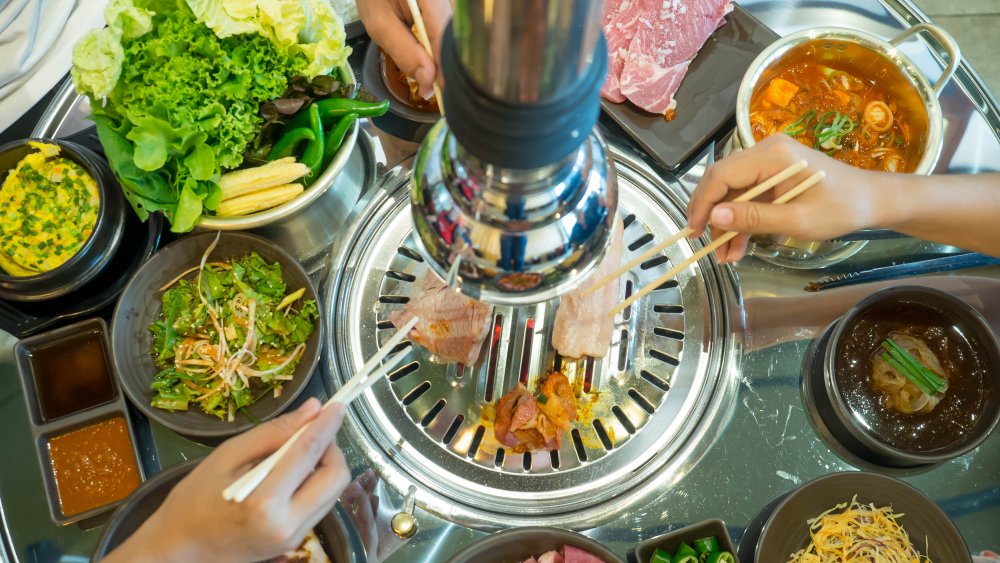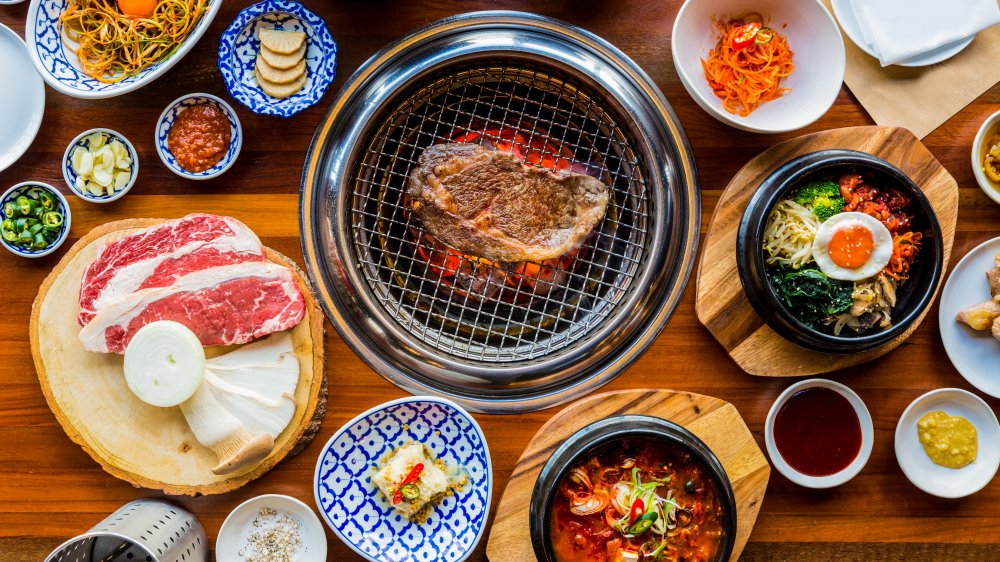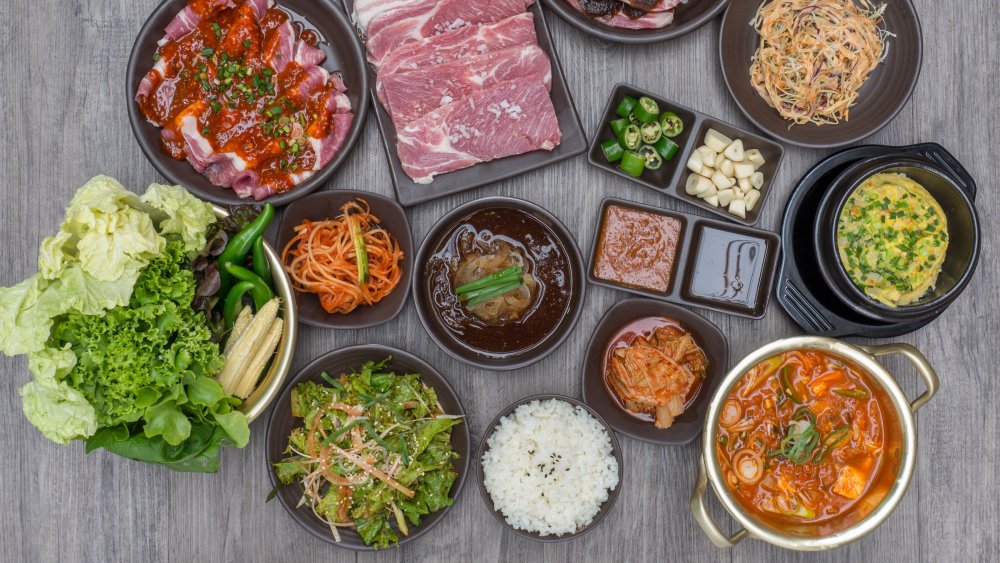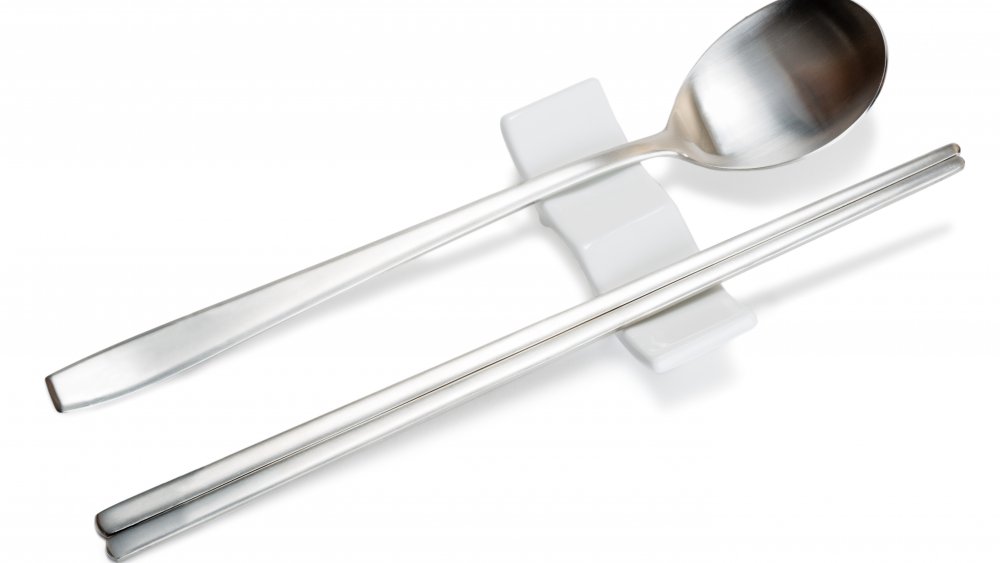The Untold Truth Of Korean Barbecue
Korean barbecue is hip and trendy now, but its origins can be traced back to a nomadic group of people, called the Maek, in central Asia (via Korean BBQ). This group brought pre-seasoned meats with them, a novel method of seasoning meat before it was cooked that was different than what most of Northeast Asia had experienced up to this point. It is believed this technique was developed as a food prep time saver for a tribe that was always wandering. The popularity of cooking and eating these seasoned meats prepared over an open fire caught on and was quickly adopted by the entire Korean peninsula.
Banchan, which is translated as "side dish" and includes popular dishes like kimchi and bibimbap, became a focal point of Korean food with the spread of Buddhism. The Buddhists shunned the consumption of meat, resulting in an array of creative vegetable dishes. When the Mongolians took control of Korea as a vassal state in 1231 to 1259, meat was once again an important part of the diet, but banchan had, thankfully, already secured its spot in Korean cuisine (via Food Worth Writing For).
Together, these grilled meats and banchan are what we call Korean barbecue. And if you find your mouth watering at just the thought of this meal, you are not alone. Korean barbecue has foodies and culinary snobs going wild big time over this cultural dining experience. But what is this Korean feast all about?
Korean barbecue's meaty experience
If you haven't experienced Korean barbecue, you may want to rally the squad to gather around the table grill for this feast. You're going to be cooking the meat yourself, so if there's a grill master in your circle of dining friends, include him or her. You will be doing the turning, flipping, and cutting the meat into small bites, but that's part of the fun and leads to some of the best conversations (via Urban Adventure). Carnivore-loving friends are also required because this meal definitely has the meats — think chicken, pork, and beef. One of the more popular meats is called bulgogi. Bulgogi means "fire meat" and is generally made from thinly sliced beef, usually tenderloin, top sirloin, or rib eyes, marinated in a sweet and savory sauce that might contain soy sauce, brown sugar, garlic, ginger, black pepper and sesame oil (via My Korean Kitchen).
If beef isn't your jam, try buldak, aka "fire chicken." It is marinated in a spicy, sweet sauce and often served with a layer of cheese melted over it. But whatever meat you choose, you will want to use some ssamjang on it. Ssamjang is the sweet (and sometimes spicy) dipping sauce for Korean barbecue. Made from soybean paste, a dollop of this sauce goes on the lettuce or perilla leaves used to create a wrap. Perilla leaves are part of the mint family and pair especially well with the rich flavor of your grilled beef (via Serious Eats).
The Korean barbecue side dishes
And you don't want to forget the side dishes, either. These little plates are one of the best parts of Korean barbecue. Dribble your banchan on to your lettuce wrap, add them to your rice, or just nibble at them in between meats and wraps. There is no way to go wrong with your banchan except if you don't savor each and every one of them.
And there are a lot of these little dishes to try. Beyond the usual suspects like kimchi, rice, and seaweed, you will definitely want to make certain you order some of the jeon, which are similar to pancakes. Whether they be scallion or garlic, these savory pancakes are an absolute must if you are having Korean barbecue.
Also, you will want to try the mung bean jelly or cheongpomuk. This is great to have in between wraps. Made from mung bean starch and drizzled with sesame oil, it serves as a palette cleanser. Its flavor is not to be missed. And don't forget the savory custard called gyeran jjim, which is a salty egg dish, or the pickled radishes either. They add incredible depth and texture to this Korean culinary adventure (via Thrillist).
Korean barbecue etiquette
Of course, every dining experience has its etiquette, and Korean barbecue is no different. First, Korean restaurants differ from many other Asian dining experiences in that they use metal chopsticks. Don't be afraid to ask for a pair of wooden chopsticks instead, though. They are easier to manipulate and also provide you with a paper wrapper that you can fold and create a little rest for your chopsticks. Use your hands to grab your lettuce leaves, but use your chopsticks to take bits of your banchan to add to your lettuce wrap.
And just like sushi, your little lettuce wraps of meat are meant to be one-bite delights. When you are cooking your meat on the grill, only flip it once and don't forget to change out the grill in between meats. This ensures you don't mix the flavors of each item you are barbecuing. Also, remember, the banchan is meant to be shared, so even if you find there is one you favor more than the others, don't be selfish. Also, do not count on eating dessert at Korean barbecue. They don't serve it and, honestly, you won't have room for it (via Thrillist).



